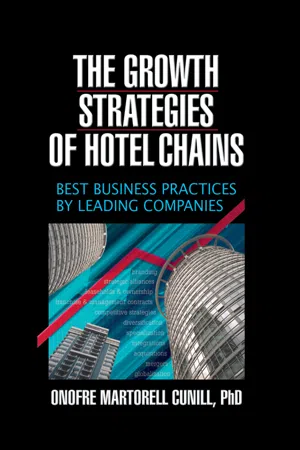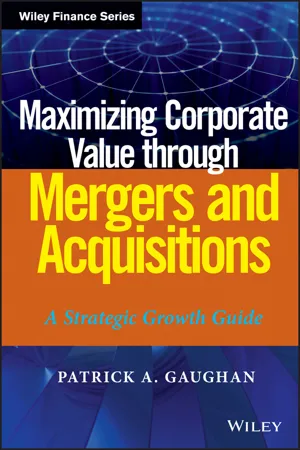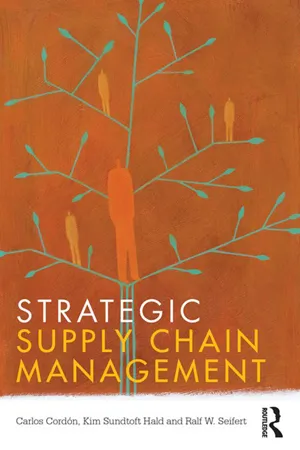Business
Horizontal Integration
Horizontal integration refers to a business strategy where a company expands its operations by acquiring or merging with competitors at the same stage of the production process. This allows the company to increase its market share, reduce competition, and potentially achieve economies of scale. By integrating horizontally, a company can gain more control over the supply chain and distribution channels.
Written by Perlego with AI-assistance
Related key terms
Related key terms
1 of 4
Related key terms
1 of 3
8 Key excerpts on "Horizontal Integration"
- eBook - ePub
The Growth Strategies of Hotel Chains
Best Business Practices by Leading Companies
- Kaye Sung Chon(Author)
- 2006(Publication Date)
- Routledge(Publisher)
Chapter 5 Horizontal IntegrationThe TheoryHorizontal Integration takes place when several companies, all involved in the same level of the production chain, join forces to achieve a greater degree of concentration in a particular industry. Company owners integrate in this way to increase their purchasing power in relation to their suppliers and to increase their control of the distribution and sales of their product in the marketplace (monopoly power). An extreme case of Horizontal Integration occurred in the mid-1970s, when the countries that produce and export cooking oil formed a cartel to raise the price of oil by multiplying its original price four times.Authors who specialize in Horizontal Integration do not believe that all companies have one optimum size (although factories or exploitation activities, such as mines or farming operations, may). Nevertheless, they accept that certain effects can reduce average costs when either production or the scope of a company’s business operations increases. In other words, they believe in economies of scale. When these effects raise the average costs, it is referred to as diseconomies of scale.In this sense, discussions have been held on a series of positive or negative effects of factors on a company’s size and growth. These factors have led to several different theories on how economies of scale are created. The now classic work by Robinson (1957) is an interesting basis for an examination of these effects. Robinson classifies these factors into technical, management-based, financial, sales-related, and risk-based factors.Technical FactorsTechnical factors partly determine a company’s size. However, to what extent they determine its size and whether they operate in the same way and have the same interrelations as other factors do should be ascertained. - eBook - ePub
Corporate Level Strategy
Theory and Applications
- Olivier Furrer(Author)
- 2016(Publication Date)
- Routledge(Publisher)
Chapter 10 Vertical Integration Coordinating the Value ChainDOI: 10.4324/9781315855578-10Vertical integration refers to the corporate level strategy by which a firm diversifies its activities along the industry value chain, whether by producing its own input (i.e., backward, or upstream, integration) or disposing of its own outputs (i.e., forward, or downstream, integration) (Grant, 2013 ; Harrigan, 1984 , 1985a ). Vertical integration increases a firm’s value added margins for a specific processing chain (Harrigan, 1985a) (see Figure 10.1 ) and thereby enjoys scale or integration economies, as well as greater control over sources of raw material or distribution outlets (Pfeffer & Salancik, 1978 ; Scherer & Ross, 1990 ).Figure 10.1 Stages in the industry value chainVertical integration, as a corporate level strategy, is often one of the first diversification strategies that firms embrace (Harrigan, 1984 ). Vertical integration can be assimilated to a corporate level strategy because it refers to the scope of a firm when it chooses to compete in particular value-adding stages of an industry value chain (Hofer & Schendel, 1978 ). Yet vertical integration also constitutes an internalization strategy (Williamson, 1975 ), in transaction cost theory terms, because the firm performs activities itself instead of relying on external suppliers or buyers.One of the famous examples of a fully vertically integrated firm is the Carnegie Steel Company during the late 1880s. At the height of its growth, the firm controlled not only the mills that manufactured the steel but also the mines from which the iron ore was extracted, the coal mines that supplied the coal, the ships that transported the iron ore to the factory, the railroads that transported the coal, the coke ovens that cooked the coal, and so on, along the entire value chain (Livesay, 1999 - eBook - ePub
Maximizing Corporate Value through Mergers and Acquisitions
A Strategic Growth Guide
- Patrick A. Gaughan(Author)
- 2013(Publication Date)
- Wiley(Publisher)
One of the benefits of being vertically integrated is that it can lower some of the risks a company faces in the marketplace. Buying a supplier can allow a company to have greater certainty in access to supplies. It may also allow these supplies to be more dependably available at more predictable prices. When getting access to key supplies is a major risk factor, companies may be able to lower this risk through vertical integration. By acquiring a supplier, they may be able to get a dependable source of inputs while possibly being able to gain a competitive advantage by preventing these supplies from being available to the competition. This competitive advantage may carry with it antitrust ramifications, but as markets have become increasingly globalized, most deals, especially vertical ones, tend to move through the antitrust approval process without a great deal of opposition.VERTICAL INTEGRATION AS A PATH TO GLOBAL GROWTH
When a company manufactures a product, it obviously has to get that product to its ultimate consumers. Even if a company has superior products, if competitors have the distribution channels locked up, the company may be at an insurmountable disadvantage. Sometimes, M&A can be the solution to this dilemma.Many industries have different layers or stages with some being more competitive than others. For example, the petroleum industry has multiple stages from exploration and extraction to transportation and refining to the retail stage. Some stages are more profitable than others. We discuss later in this chapter how U.S. companies reacted to the changing profitability in the refining business to become less vertically integrated and to sell off their refining businesses. However, for other industries, being vertically integrated is a way of making sure that your products have a clear path to the consumer and that you will not be adversely affected by the actions of competitors. Companies may want to try to control as many outlets for their products as possible to ensure that they can maintain prices that allow them to extract maximum economic rents for their products. Often, such efforts are thwarted by regulators. One prominent example of how this was done in the United States, but also in the global, market without attracting resistance from antitrust regulators was that of eyeglass manufacturer and marketer Luxottica. We discuss this company's very successful use of a vertical integration strategy in the case study that follows. - eBook - ePub
Strategic Management
The Challenge of Creating Value
- Peter FitzRoy, James M. Hulbert, Timothy O'Shannassy(Authors)
- 2016(Publication Date)
- Routledge(Publisher)
When considering this vertical industry system, the firm must decide whether or not to expand its scope into immediately adjoining stages. This is normally referred to as vertical integration, and we now turn our attention to these decisions.Vertical integration
The objective of vertical integration is to achieve higher profitability through the elimination of the customer or supplier, bringing their margins under the firm’s control. Backward integration requires new operational skills; forward integration requires new marketing skills, at the same time creating competition with existing customers (Harrigan, 1983).Vertical integration is motivated by the idea that the business can create additional value when more activities share common ownership. So where do these advantages come from? One source may be joint production economies – there are efficiency gains from linking two activities together.Integration may also provide protection against asset specificity, where the business can be held to ransom by a monopoly supplier or customer. In these cases of market failure, the firm probably has no choice but to vertically integrate, as has occurred in some resource-based industries such as aluminium. In many food products, however, the market for raw materials is more competitive, and few food processors have vertically integrated backwards into agriculture.There are several issues with vertical integration as a business strategy. Vertical integration inevitably results in an increasing proportion of a firm’s or business’s assets being in one industry, thus increasing dependency on it. In the car industry, for example, if we currently make cars and acquire a tyre producer, we have not diversified in terms of industry; we have even more assets in the car industry, increasing exposure to changes in industry demand. Such actions may be taken defensively, to protect our original investment, although this may be dangerous, throwing good money after bad.It may also be difficult to balance scale and capacity (Díez-Vial, 2007). We can see this by using a hypothetical but realistic example from the car industry. Suppose the efficient size of plant for cars is 400,000 units per year, requiring two million tyres per year. Let us further assume that the car firm builds an efficient-sized tyre plant that produces three million tyres per year. The question then is: What do we do with the extra one million tyres per year? Do we attempt to sell them to our competitors and will they purchase from a competitor? Or will we sell the extra product to the aftermarket for replacement tyres? If so, we will need a strong retail marketing group. If neither of these alternatives seems feasible, the tyre plant will produce only two million tyres per year. If there are strong economies of scale, the plant will be a high-cost facility, making the cost of tyres to the car company uncompetitive. This example reinforces that an integration decision must be well thought out before choosing it as a course of action. - Colin Barrow(Author)
- 2016(Publication Date)
- For Dummies(Publisher)
Exactly where does your company stand in terms of vertical integration in your own industry? The question’s important, because it affects your decision about whether to become more or less vertically integrated over time. Several terms have been coined by business gurus to describe the strategic moves that you may decide to make:- Backward integration: Backward integration means extending your business activities in a direction that gets you closer to the raw materials, resources and expertise that go into creating and producing your company’s products.
- Forward integration: Forward integration means extending your business activities in a direction that gets you closer to the marketplace by involving the company in packaging, marketing, distribution and customer sales.
- Outsourcing: Outsourcing means concentrating on your core business activities by farming out other parts of your company’s operations to outside contractors and vendors that specialise in those particular areas.
- Divesting: Divesting means reducing your company’s activities to focus on specific aspects of your business by spinning off or selling other pieces of the company.
Tables 1-2 and 1-3 describe some of the pros and cons of vertical integration.TABLE 1-2 Pros of Vertical IntegrationProReasonEfficiencies If you’re in charge, it’s sometimes easier to co-ordinate activities at the various business stages along the way, combining related functions or getting rid of overlapping areas to streamline your overall operations.Resources If you have a hand in the upstream (early-stage) activities of a business, you can guarantee that your company has access to the raw materials and resources that it needs to stay in business. - eBook - ePub
- John Bridge, J. C. Dodds(Authors)
- 2018(Publication Date)
- Routledge(Publisher)
Vertical integration may occur backwards in which case the firm becomes engaged in operations previously undertaken by suppliers, for example, the manufacture of basic materials or components, or forwards, which involves the extension of operations towards the consumer, that is in distribution or retailing. The strategy offers limited opportunities for growth, but clearly there are only a finite number of operations between extraction of basic materials and sale of the final product. Vertical integration may offer greater security, a motive stressed by E.A.G. Robinson (136):Vertical integration is sometimes the consequence of a reuniting of separated processes of production. It is more often the consequence of a search for security. [p. 110]The security results from regularity of supply or the guarantee of a retail outlet, but, despite this kind of advantage, the firm’s dependence on a particular segment of economic demand leaves it sensitive to variations in the market and less able to respond to change. The same technology may run through several stages of the total operation, in which case the firm may benefit from synergy, but frequently the technology will differ (motor-vehicle manufacture and assembly involves an entirely different technology from the manufacture of electrical components for vehicles). Certainly a firm which enters retailing activities from a manufacturing base is unlikely to possess the managerial skills within its existing organisation, although typically this type of forward integration would be accomplished by taking over an existing concern. An associated disadvantage in connection with integration by acquisition is that the subsidiary may itself be diversified and consequently be engaged in types of production which have no natural relationship to the activities of the parent.Profit advantages may accrue through integration if the rates of return in the other stages of production are higher than in the original stage. There may also be cost savings which result from being able to avoid certain market transactions and associated selling costs. The assured supplies and orders which follow vertical integration also enable contingency stocks to be run down with a consequent release of working capital which can be re-invested profitably elsewhere in the business. It is not always true, however, that avoiding the market (for intermediate products) enables costs to be reduced, since administrative procedures do not necessarily provide a more efficient means of co-ordinating producer and user than the mechanism of the market. Furthermore, the effects which vertical integration may have on competition may be detrimental to the efficiency of the resource allocation process in the economy as a whole. - eBook - ePub
- Carlos Cordón, Kim Sundtoft Hald, Ralf W. Seifert(Authors)
- 2013(Publication Date)
- Routledge(Publisher)
2.1 Effect on profitability of sales increase vs. supply chain improvementBase10% sales increase10% supply chain improvementSales ($) 100 110 100 Supply chain costs ($) 70 77 63 SG&A ($) 20 20 20 Profit ($) 10 13 17Vertically and horizontally integrated supply chains
The level of vertical integration is the degree of integration up and down a supply chain. For example, if a retailer starts manufacturing the products it sells, it is increasing its level of vertical integration. Vertical integration may be upstream or downstream. The interesting question is, how many consecutive steps in the supply chain should the company control and own? Two extremes are the Ford Motor Company in the 1920s and Lacoste today. Ford was known in the early 20th century for owning all of the supply chain tasks, from managing the plantations that produced rubber for the tires, to tire making, car assembly and delivery. By contrast, Lacoste is an almost fully outsourced company: manufacturing and distribution are entirely outsourced, while marketing and design are largely outsourced.The level of Horizontal Integration is the breadth of activities at the same point in the supply chain. A typical method of increasing the level of Horizontal Integration is to acquire other companies or brands in the same business. For example, supermarkets that are moving toward selling a larger variety of non-food items are increasing their level of Horizontal Integration. Another example is Volkswagen’s efforts to merge with Porsche: by merging with another brand in the same field, Volkswagen was able to consolidate its activities and thereby achieve economies of scale.Although in the last century we have seen many companies pursue a much lower level of vertical integration, this evolution does not mean that companies must strive for vertical disintegration. If anything, today there are extremely successful corporations like Inditex (the owner of the Zara fashion chain) and Luxottica (the world leader in eyewear) that have a high level of vertical integration, but there are also thriving companies like Hewlett-Packard that have a very low level of vertical integration. Thus, it cannot be said that a high or low level of vertical integration on its own is the key to success. The main advantages and drivers of vertical integration of supply chain flows are: - Colin Barrow(Author)
- 2023(Publication Date)
- For Dummies(Publisher)
Exactly where does your company stand in terms of vertical integration in your own industry? The question’s important, because it affects your decision whether to become more or less vertically integrated over time. Several terms have been coined by business gurus to describe the strategic moves that you may decide to make:- Backward integration means extending your business activities in a direction that gets you closer to the raw materials, resources and expertise that go into creating and producing your company’s products.
- Forward integration means extending your business activities in a direction that gets you closer to the marketplace by involving the company in packaging, marketing, distribution and customer sales.
- Outsourcing means concentrating on your core business activities by farming out other parts of your company’s operations to outside contractors and vendors that specialise in those particular areas.
- Divesting means reducing your company’s activities to focus on specific aspects of your business by spinning off or selling other pieces of the company.
Tables 1-2 and 1-3 describe some of the pros and cons of vertical integration.TABLE 1-2 Pros of Vertical IntegrationProReasonEfficiencies If you’re in charge, it’s sometimes easier to coordinate activities at the various business stages along the way, combining related functions or getting rid of overlapping areas to streamline your overall operations.Resources If you have a hand in the upstream (early-stage) activities of a business, you can guarantee that your company has access to the raw materials and resources that it needs to stay in business.
Index pages curate the most relevant extracts from our library of academic textbooks. They’ve been created using an in-house natural language model (NLM), each adding context and meaning to key research topics.
Explore more topic indexes
Explore more topic indexes
1 of 6
Explore more topic indexes
1 of 4







